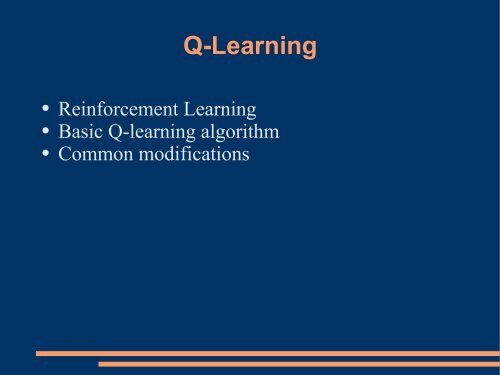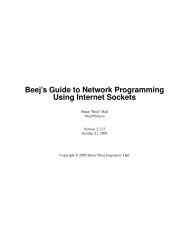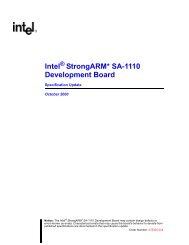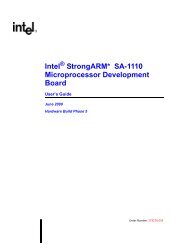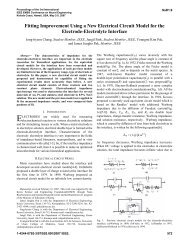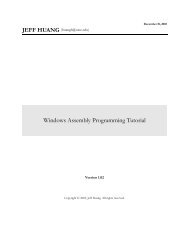Q-Learning
Q-Learning
Q-Learning
You also want an ePaper? Increase the reach of your titles
YUMPU automatically turns print PDFs into web optimized ePapers that Google loves.
Q-<strong>Learning</strong><br />
●<br />
●<br />
●<br />
Reinforcement <strong>Learning</strong><br />
Basic Q-learning algorithm<br />
Common modifications
Reinforcement <strong>Learning</strong><br />
●<br />
●<br />
●<br />
●<br />
●<br />
Delayed reward<br />
– We don't immediately know whether we did the correct<br />
thing<br />
Encourages exploration<br />
We don't necessarily know the precise results of<br />
our actions before we do them<br />
We don't necessarily know all about the current<br />
state<br />
Life-long learning
Our Problem<br />
●<br />
●<br />
●<br />
●<br />
●<br />
We don't immediately know how beneficial our<br />
last move was<br />
Rewards: 100 for win, -100 for loss<br />
We don't know what the new state will be from an<br />
action<br />
Current state is well defined<br />
Life-long learning?
Q-<strong>Learning</strong> Basics<br />
● At each step s, choose the action a which<br />
maximizes the function Q(s, a)<br />
– Q is the estimated utility function – it tells us how<br />
good an action is given a certain state<br />
● Q(s, a) = immediate reward for making an action +<br />
best utility (Q) for the resulting state<br />
● Note: recursive definition<br />
● More formally ...
Formal Definition<br />
Q s , a=r s ,amax a' Q s ' , a' <br />
r s ,a=Immediate reward<br />
=relative value of delayed vs. immediate rewards (0 to 1)<br />
s'=the new state after action a<br />
a , a' :actions in states s and s ' , respectively<br />
Selected action:<br />
s=argmax a<br />
Q s , a
Q <strong>Learning</strong> Algorithm<br />
For each state-action pair (s, a), initialize the table entry Q s , a to zero<br />
Observe the current state s<br />
Do forever:<br />
---Select an action a and execute it<br />
---Receive immediate reward r<br />
---Observe the new state s'<br />
---Update the table entry for Qs , a as follows:<br />
Qs ,a=r max a ' Q s' ,a ' <br />
--- s=s '
Example Problem<br />
a12<br />
a23<br />
s1 s2 s3<br />
a21<br />
a32<br />
a36<br />
a25<br />
a14 a41 a45 a52 a56<br />
s4 s5 End: s6<br />
a54<br />
γ = .5, r = 100 if moving into state s6, 0 otherwise
Initial State<br />
s1, a12 0<br />
s1, a14 0<br />
s2, a21 0<br />
s2, a23 0<br />
s2, a25 0<br />
s3, a32 0<br />
s3, a36 0<br />
s4, a41 0<br />
s4, a45 0<br />
s5, a54 0<br />
s5, a52 0<br />
s5, a56 0<br />
s1 s2 s3<br />
a14 a41<br />
a12<br />
a21<br />
a45<br />
a25<br />
a52<br />
a23<br />
a32<br />
a56<br />
s4 s5 End: s6<br />
a54<br />
a36
The Algorithm<br />
s1, a12 0<br />
s1, a14 0<br />
s2, a21 0<br />
s2, a23 0<br />
s2, a25 0<br />
s3, a32 0<br />
s3, a36 0<br />
s4, a41 0<br />
s4, a45 0<br />
s5, a54 0<br />
s5, a52 0<br />
Current Position: Red<br />
Available actions: a12, a14<br />
Chose a12<br />
a12<br />
s1 s2 s3<br />
a14 a41<br />
a21<br />
a45<br />
a25<br />
a52<br />
a23<br />
a32<br />
a56<br />
s4 s5 End: s6<br />
a54<br />
a36
Update Q(s1, a12)<br />
s1, a12 0<br />
s1, a14 0<br />
s2, a21 0<br />
s2, a23 0<br />
s2, a25 0<br />
s3, a32 0<br />
s3, a36 0<br />
s4, a41 0<br />
s4, a45 0<br />
s5, a54 0<br />
s5, a52 0<br />
Current Position: Red<br />
Available actions: a21, a25, a23<br />
Update Q(s1, a12):<br />
Q(s1, a12) = r + .5 * max(Q(s2,a21),<br />
Q(s2,a25), Q(s2,a23))<br />
= 0<br />
a12<br />
s1 s2 s3<br />
a14 a41<br />
a21<br />
a45<br />
a25<br />
a52<br />
a23<br />
a32<br />
a56<br />
s4 s5 End: s6<br />
a54<br />
a36
Next Move<br />
s1, a12 0<br />
s1, a14 0<br />
s2, a21 0<br />
s2, a23 0<br />
s2, a25 0<br />
s3, a32 0<br />
s3, a36 0<br />
s4, a41 0<br />
s4, a45 0<br />
s5, a54 0<br />
s5, a52 0<br />
Current Position: Red<br />
Available actions: a21, a25, a23<br />
Chose a23<br />
a12<br />
s1 s2 s3<br />
a14 a41<br />
a21<br />
a45<br />
a25<br />
a52<br />
a23<br />
a32<br />
a56<br />
s4 s5 End: s6<br />
a54<br />
a36
Update Q(s2, a23)<br />
s1, a12 0<br />
s1, a14 0<br />
s2, a21 0<br />
s2, a23 0<br />
s2, a25 0<br />
s3, a32 0<br />
s3, a36 0<br />
s4, a41 0<br />
s4, a45 0<br />
s5, a54 0<br />
s5, a52 0<br />
Current Position: Red<br />
Available actions: a32, a36<br />
Update Q(s1, a12):<br />
Q(s2, a23) = r + .5 * max(Q(s3,a32),<br />
Q(s3,a36))<br />
= 0<br />
a12<br />
s1 s2 s3<br />
a14 a41<br />
a21<br />
a45<br />
a25<br />
a52<br />
a23<br />
a32<br />
a56<br />
s4 s5 End: s6<br />
a54<br />
a36
Next Move<br />
s1, a12 0<br />
s1, a14 0<br />
s2, a21 0<br />
s2, a23 0<br />
s2, a25 0<br />
s3, a32 0<br />
s3, a36 0<br />
s4, a41 0<br />
s4, a45 0<br />
s5, a54 0<br />
s5, a52 0<br />
Current Position: Red<br />
Available actions: a32, a36<br />
Chose a36<br />
a12<br />
s1 s2 s3<br />
a14 a41<br />
a21<br />
a45<br />
s4 s5 End: s6<br />
a54<br />
a25<br />
a52<br />
a23<br />
a32<br />
a56<br />
a36
Update Q(s3,a36)<br />
s1, a12 0<br />
s1, a14 0<br />
s2, a21 0<br />
s2, a23 0<br />
s2, a25 0<br />
s3, a32 0<br />
s3, a36 100<br />
s4, a41 0<br />
s4, a45 0<br />
s5, a54 0<br />
s5, a52 0<br />
Current Position: Red<br />
FINAL STATE!<br />
Update Q(s1, a12):<br />
Q(s2, a23) = r = 100<br />
a12<br />
s1 s2 s3<br />
a14 a41<br />
a21<br />
a45<br />
a25<br />
a52<br />
a23<br />
a32<br />
a56<br />
s4 s5 End: s6<br />
a54<br />
a36
New Game<br />
s1, a12 0<br />
s1, a14 0<br />
s2, a21 0<br />
s2, a23 0<br />
s2, a25 0<br />
s3, a32 0<br />
s3, a36 100<br />
s4, a41 0<br />
s4, a45 0<br />
s5, a54 0<br />
s5, a52 0<br />
Current Position: Red<br />
Available actions: a21, a25, a23<br />
Chose a23<br />
a12<br />
s1 s2 s3<br />
a14 a41<br />
a21<br />
a45<br />
a25<br />
a52<br />
a23<br />
a32<br />
a56<br />
s4 s5 End: s6<br />
a54<br />
a36
Update Q(s2, a23)<br />
s1, a12 0<br />
s1, a14 0<br />
s2, a21 0<br />
s2, a23 50<br />
s2, a25 0<br />
s3, a32 0<br />
s3, a36 100<br />
s4, a41 0<br />
s4, a45 0<br />
s5, a54 0<br />
s5, a52 0<br />
Current Position: Red<br />
Available actions: a32, a36<br />
Update Q(s1, a12):<br />
Q(s2, a23) = r + .5 * max(Q(s3,a32),<br />
Q(s3,a36))<br />
= 0 + .5 * 100 = 50<br />
a12<br />
s1 s2 s3<br />
a14 a41<br />
a21<br />
a45<br />
a25<br />
a52<br />
a23<br />
a32<br />
a56<br />
s4 s5 End: s6<br />
a54<br />
a36
Final State (after many iterations)<br />
s1, a12 25<br />
s1, a14 25<br />
s2, a21 12.5<br />
s2, a23 50<br />
s2, a25 25<br />
s3, a32 25<br />
s3, a36 100<br />
s4, a41 12.5<br />
s4, a45 50<br />
s5, a54 25<br />
s5, a52 25<br />
s5, a56 100<br />
s1 s2 s3<br />
a14 a41<br />
a12<br />
a21<br />
a45<br />
a25<br />
a52<br />
a23<br />
a32<br />
a56<br />
s4 s5 End: s6<br />
a54<br />
a36
Properties<br />
●<br />
●<br />
●<br />
●<br />
Convergence: Our approximation will converge to<br />
the true Q function<br />
– But we must visit every state-action pair infinitely<br />
many times!<br />
Table size can be very large for complex<br />
environments like a game<br />
We do not estimate unseen values<br />
How to we fix these problems?
Neural Network Approximation<br />
●<br />
●<br />
Instead of the table, use a neural network<br />
– Inputs are the state and action<br />
– Output is a number between 0 and 1 that represents the<br />
utility<br />
Encoding the states and actions *properly* will be<br />
challenging<br />
– Helpful idea: multiple neural networks, one for each<br />
action
Enhancements<br />
●<br />
●<br />
●<br />
Exploration strategy<br />
Store past state-action transitions and retrain on<br />
them periodically<br />
– The values may change as time progresses<br />
Temporal Difference <strong>Learning</strong>
Exploration Strategy<br />
●<br />
●<br />
●<br />
Want to focus exploration on the good states<br />
Want to explore all states<br />
Solution: Randomly choose the next action<br />
– Give a higher probability to the actions that currently<br />
have better utility<br />
P a i<br />
∣s=<br />
∑<br />
j<br />
k Qs , a i<br />
<br />
k Qs , a i
Temporal Difference (TD) <strong>Learning</strong><br />
●<br />
●<br />
●<br />
●<br />
Look farther into the future of a move<br />
Update the Q function after looking farther ahead<br />
Speeds up the learning process<br />
We will discuss this more when the time comes


